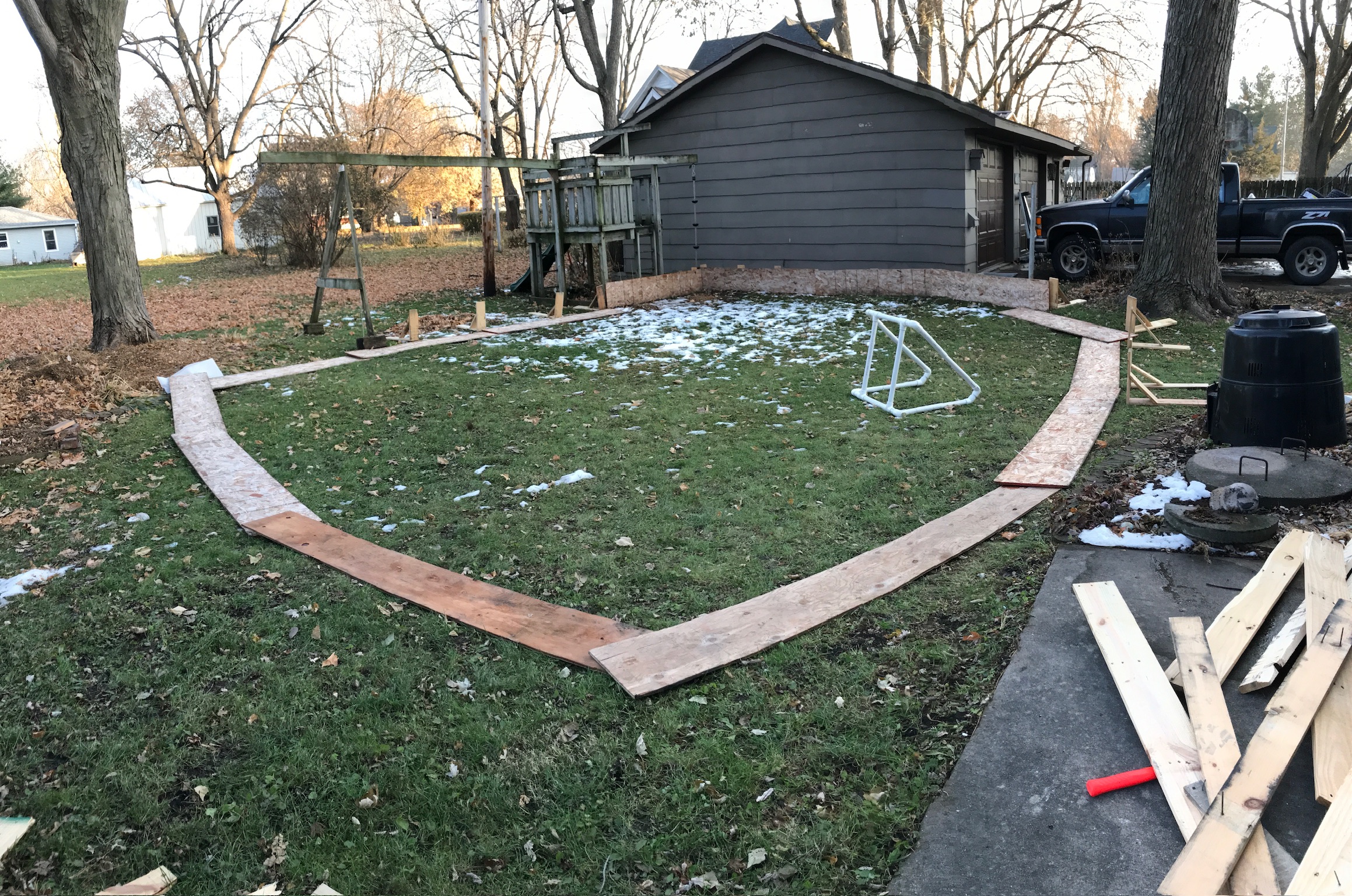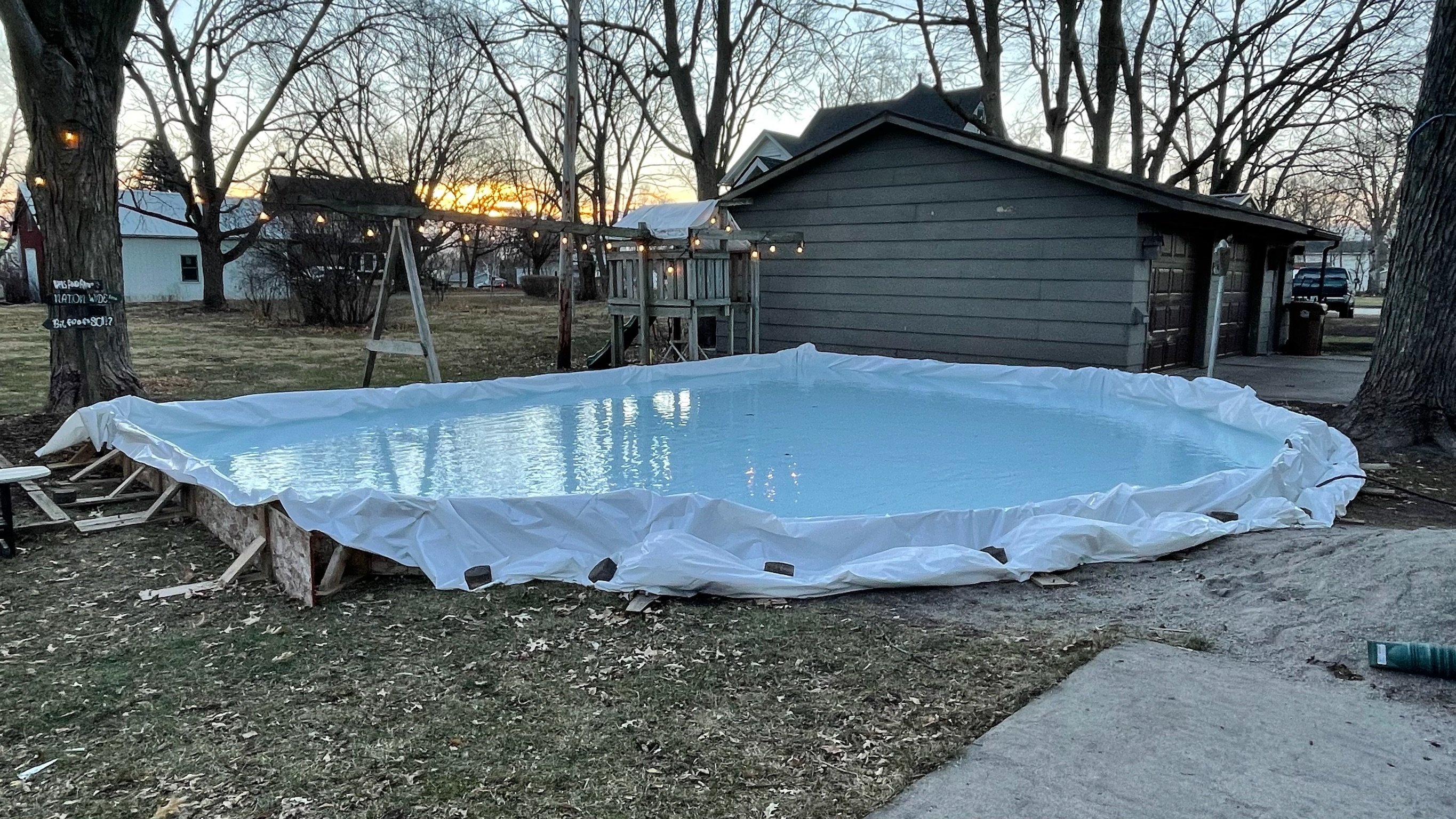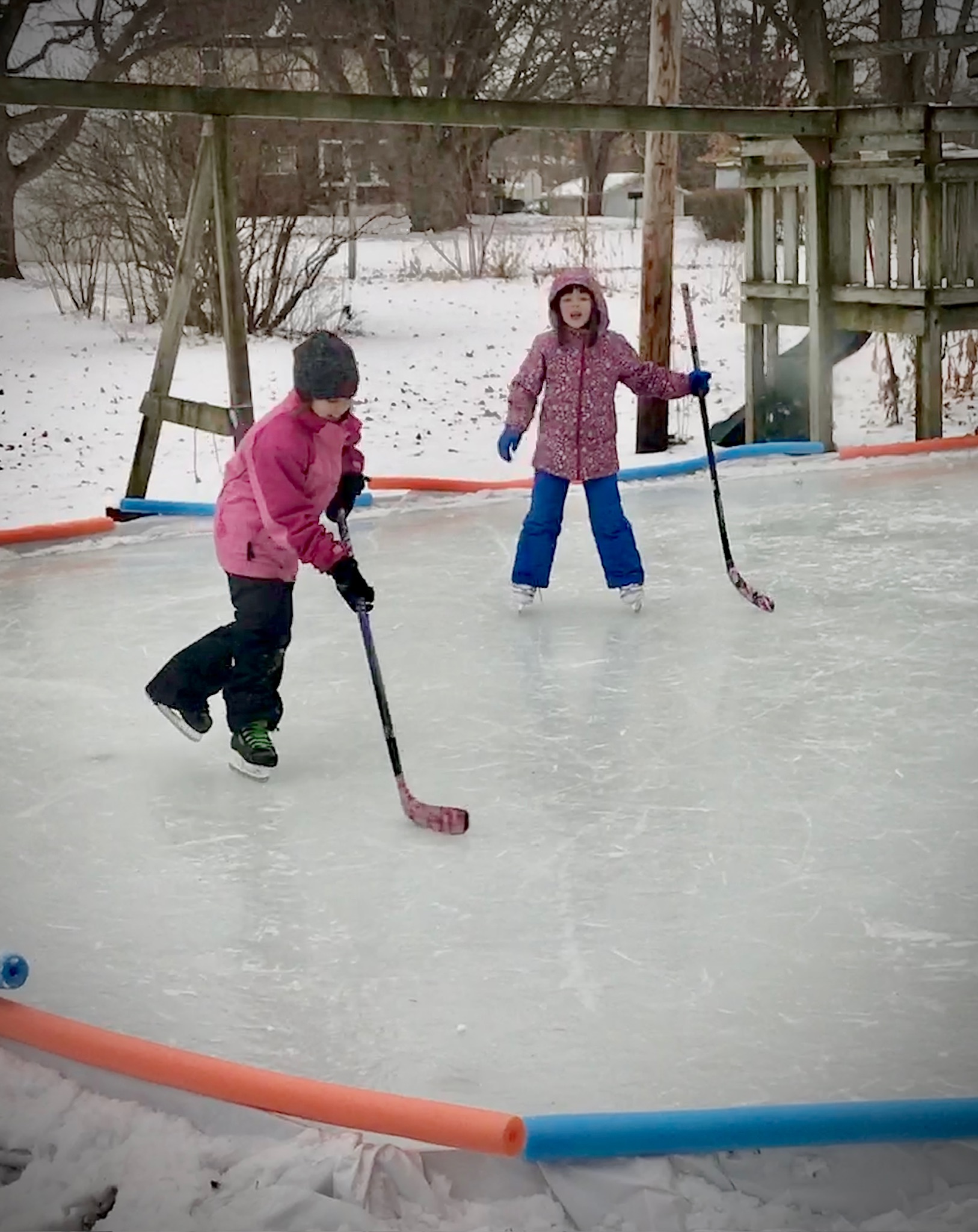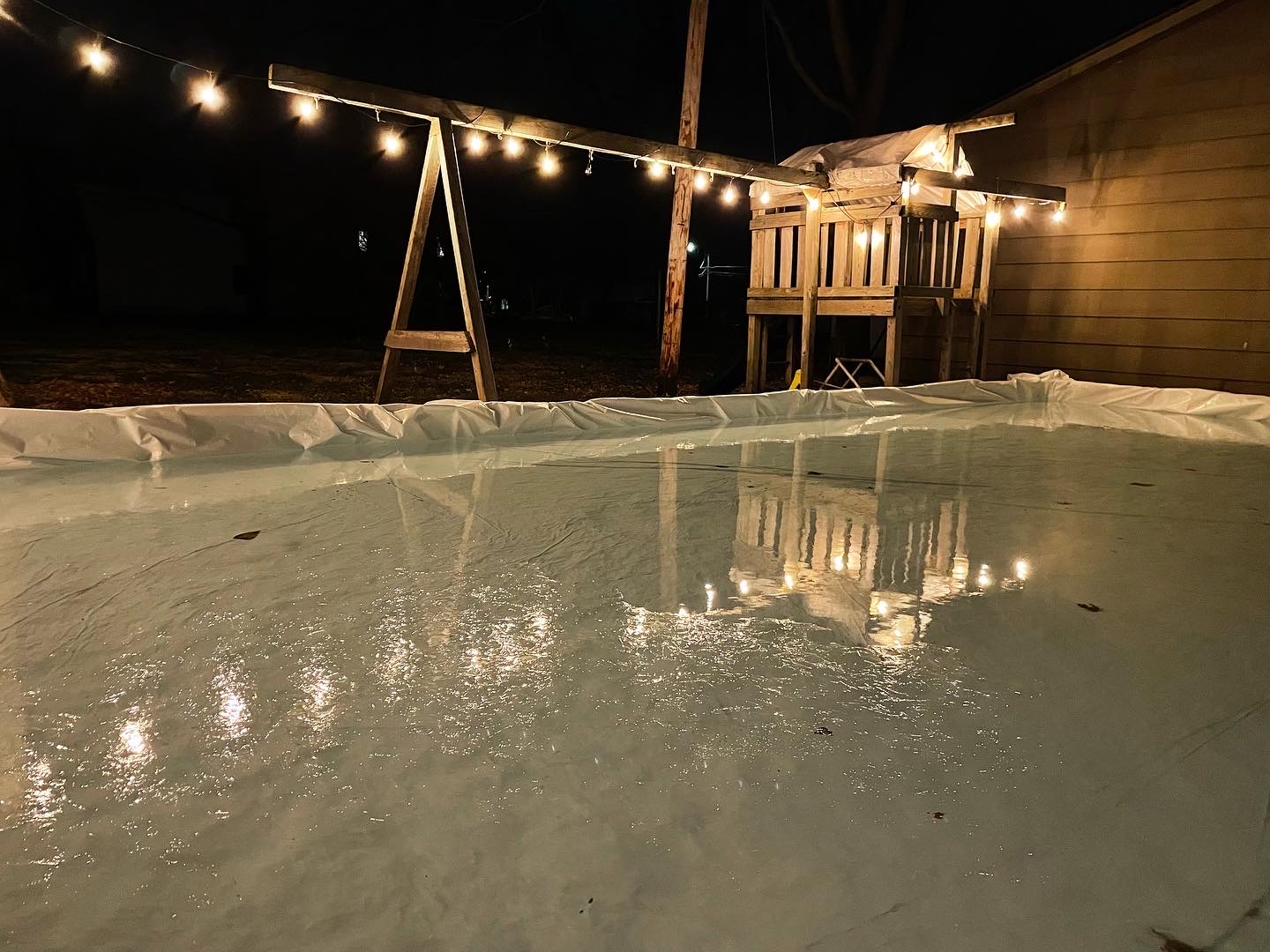Each year I know that eventually winter will come to Grinnell, Iowa, the place I call home. On this patch of the American prairie, some enjoy the solitude of ice fishing on a pond or lake, while others favor the roar of a snowmobile across a sea of freshly fallen snow. Some kids like to build forts and pelt each other with snowballs. But as for me and my family, since 2010 we have discovered the joy of skating by building an ice-skating rink on our property.
Yes, a rink. Our neighbors put up their swimming pool each summer and no one bats an eye at that. So, if you’re struggling to picture why we go to the trouble of building a rink for two or three months of winter play, just picture us hard at work on a very shallow swimming pool. Fellow backyard rink builder Barbara Falla said, “Anyone can love summer, but to love winter you have to carry your sunshine with you.” We find our sunshine on the ice. It’s wonderful how ice can be so warm.
A history of skating
Winter Landscape with Skaters and Birds Trap, painted by Renaissance painter Pieter Bruegel the Elder in 1565, depicted people at play on the ice, a sharp contrast from prior generations whose paintings showed people at work. 1 It’s believed to be the first depiction of ice skating.
Dutch artist Hendrick Avercamp painted many winter landscapes that depicted people on ice, mostly at play. If you look carefully at his 1608 work Winter Landscape with Skaters, you can see what art historians claim are people playing a version of golf on the ice. I’m guessing they were playing a forerunner of hockey instead.
One of the best-documented skating jaunts took place 180 years ago and the setup sounds like a joke an English major might tell. Nathaniel Hawthorne, Henry David Thoreau, and Ralph Waldo Emerson headed down to the Concord River to go ice skating. Sophia Hawthorne, Nathaniel’s spouse, recounted the scene in a letter: Thoreau, the experienced skater, leaping and dancing wildly as he glided. Emerson, doubled-over and statue-like. Emerson described Hawthorne as the indefatigable Trojan War hero, Ajax, on ice. 2
One of my favorite books about the joys of skating and winter is Twelve Kinds of Ice, by Mary Bryan Obed. In the book, she describes the different kinds of ice that come each year, starting with The First Ice — “a skim of ice so thin that it broke when we touched it.” The Second Ice was the ice you could pick out of a pail, and the Third Ice was “the ice that would not break. We hit it with the heels of our boots. We tapped it with the handle of an old rake. But the ice stayed firm.” That ice, and the accompanying chill of winter, brings Field Ice, then Stream Ice, then Black Ice — not the black ice you might encounter on a highway overpass, but what Obed describes as “water shocked still by the cold before the snow.” 3
You can find videos on YouTube or Facebook of people skating on black ice. They skate out to the middle of a pond or lake, “the forbidden place of frothing whitecaps in the summer,” according to Obed.
In Walden, Thoreau described black ice as “interesting and perfect, being hard, dark, and transparent,” and went on to describe viewing the pond as if through a window pane to the inky depths below.
So: how exactly does water freeze to form a window solid enough to glide across in knife shoes? Let’s explore the science of ice.
The Greek word krystallos can roughly be translated to “coldness drawn together.” Though chemists and engineers have discovered at least 14 forms of ice, the ice we encounter each winter is designated *Ih (*I-sub H) or hexagonal ice, scientifically speaking. Nature follows simple physical and chemical rules of self-assembly to arrange sheets of water molecules in hexagons. 4
Knowing when the ice is safe to venture onto is a part of the attraction of outdoor ice skating. In his book Home Ice, the sports writer and backyard rink builder Jack Falla recalls:
…[N]either the town Fire, Police, nor Recreation departments would pronounce any natural ice safe to skate on unless it was thick enough to support the combined tonnage of the U.S. Seventh Fleet. As for our parents, they thought the ice hadn’t been safe since the glaciers retreated.
“Our youthful standards were considerably more elastic. Besides, Long Pond was the shallowest body of water in town and anyone falling in would probably strangle in weeds before he drowned.” 5
My dad grew up in Lakewood, OH, on Cleveland’s west side. He can remember joining classmates on a flooded baseball diamond at Lakefront Park and even on the iced-over Rocky River for skating and hockey games, warming up by a burn barrel. He can also remember breaking through the ice at least once. And waiting in wet clothes to be picked up by one’s parents in the cold of winter is not a fun time, especially in an era before cell phones!
Many departments of natural resources will warn their residents, “No ice is safe ice!” But they also post helpful infographics about safe ice depth for activities ranging from skating (2") to ice fishing (5") to taking a vehicle out on the ice (6-18", depending on the machine). “One does not stroll cavalierly onto new ice,” said Falla, who tested the ice first with stick pokes, then rocks, then careful, shuffling steps.
Black ice mesmerizes the skater with its siren call. It’s a solid, transparent window into a body of water. The kids and I have visited Lake Nyanza and Arbor Lake in Grinnell, IA, where we live, and performed the stick and rock tests with a mix of disappointment and destructive glee because a stone had broken through a thin skim of ice. In Home Ice, Falla recalls one December when he tested the black ice on Long Pond one morning after finishing his paper route. He held on to a tree limb as he jumped on — and fell through — the ice, “wet to mid-thigh and covered with the most vile smelling mud this side of a compost pile.” 6
The skates we use to glide on the ice also benefit from advances in technology. The first skate blades were made of bones — the shanks of cows and horses. Can you imagine strapping a couple of those on your feet? Later, these skates were made of iron and steel. Today’s skate blades are still steel and the boots are a combination of plastics, fabric, and metal.
Building our rink
How did I get the itch? Looking back on my childhood in Bexley, OH, it certainly seems possible that other families in the Columbus metro area were building rinks, but our family didn’t know them. At the time, there was only one permanent sheet of ice — The Ohio State University rink. The Centrum, an outdoor rink in downtown Columbus, had a short run from 1978-1986, and I don’t recall skating on it. But when the minor-league hockey Columbus Chill arrived in 1991, I took notice. Attending college in Michigan certainly opened my eyes to the fact that skating (and hockey) could be a way to have fun in winter.
But as for what sparked my backyard rink, I have two people to thank: fellow Ohio native John Buccigross and the previously mentioned sportswriter Jack Falla. Buccigross, an anchor of ESPN’s SportsCenter, wrote a weekly hockey column in the first decade of the 2000s and often mentioned the rink he built in his backyard in Connecticut. In a 2009 column, he outlined the how and why of his rink, a “60-by-40- swimming pool that’s two feet deep,” sitting atop an asphalt slab in a treeless backyard. 7
As for the why, Buccigross, a self-identified hockey fan who is for many ESPN viewers the face of hockey on the network, said building a backyard rink is the inevitable next step after watching games and signing his kids up for hockey. This tracks—not just for me, but for many of my fellow rink builders. Like me, Buccigross was inspired by Jack Falla.
In 1987 Falla even went on a 2,800-mile backyard rink pilgrimage, visiting rinks in Duluth, MN and Thunder Bay, ON. He intended also to visit the mecca of backyard rinks: the Gretzky family rink maintained by the patriarch, Walter, in Brantford, ON. But alas, it was too warm that winter and Walter passed on before Falla was able to visit.
When I started writing this essay, I reached out to the two backyard ice rink groups I belong to on Facebook. I asked them why they started their rinks, why they continue, and what has surprised them about their rinks. Overwhelmingly, ike Buccigross, the 28 respondents from around the U.S., from Virginia to Utah, did it for the kids.

Photo by Dan McCue.
Some wanted to ensure their kids got ice time to develop their skills—as with the myriad basketball hoops and soccer goals sprouting on driveways and in backyards. Others just wanted to make sure their family and friends had a space and an activity where they could have fun together in the winter.
In one post, Kristie Bush-Schrotenboer of Grand Rapids, MI, wrote: “I love providing the opportunity for other kids to fall in love with skating and hockey. Every year after we get that first skate in, I say ‘all the work up to this point was worth it. If we only get this one skate. It was worth it.’” In a reply to this post, Jeff Pembroke of Pembroke, MA agreed, saying, “The rink is a magnet for hosting family and friends during the cold winter months.”
This tracks for my family too, 100 percent. Our first winter in Grinnell, I told my spouse that if we bought a house here, I wanted to build a rink in our backyard. When we bought our first house in Grinnell in 2010, we did it.
That first year, my parents were in town visiting from Ohio over the Thanksgiving break. My dad and I inspected the backyard, staking out a rink site, then went to the local lumberyard to purchase boards, rebar, and a 100-foot roll of clear plastic tarp. When the weather was right, we rolled out the plastic and flooded the rink.
When our kids were tiny, my spouse and I would put them to bed, put on our skates, and head outside with the baby monitor to have some quiet time together. When the kids got older, we got them out on the ice with us, with varying degrees of success. Like so many other rink builders, we made memories, together, outside in winter.
By now, we’ve settled into a bit of a routine. We prep the backyard, raking leaves and scouring every square inch of the yard for anything that might puncture the plastic — twigs, rocks, or black walnut shells. The day after Thanksgiving, we pull out the boards — still the same boards we first used in 2010. We pull out brackets, built from salvaged pallet wood, a pre-pandemic improvement. Like other rink builders, I’m always refining. We attach the brackets to the boards and stake the brackets in the ground with rebar. We’ve even started keeping a logbook, an idea inspired by Jack Falla.

Laying down the boards to build the ice rink. Photo by Dan McCue.
In another Facebook post, Tim Taubenheim of Milwaukie, WI, wrote: “Every year, you find something to help enhance the outdoor rink experience.” For Buccigross, this meant nailing his boards to his brackets and leaving them up year-round. For others, it was building improvised tools to resurface their rinks and other DIY improvements. “Did you know you can remove bumps and resurface a backyard rink with an iron on the end of a pole?” asked Steve Pailler of North Grafton, MA.
We wait for a favorable forecast. We’re probably the only family in Grinnell excited to see a stretch of days with highs at freezing temperatures and lows in the teens. That’s rink-flooding weather.
When the forecast is right, we roll out the tarp. This is one step I have yet to master. Unfurled, our rink tarp is 40-feet-by-35-feet, a little bit of excess for our D-shaped rink, which is laid out to accommodate a playset, garage, shed, maple tree, and other permanent obstacles. The tarp is spooled onto a three-inch-diameter, five-foot-long cardboard tube, weighing 45 pounds and folded like a life-sized highway map. We unroll the tarp and begin unfolding. Somehow we always manage to confuse length and width, and have to rotate 90 degrees.
And then, if the day is breezy, there’s the threat of the tarp becoming a sail. We use clamps and clips to keep it in place until the water can hold it down.
Finally, it’s time to flood. I bring up the hose from the basement — we have a special cold-hardy hose — and attach it to the outdoor faucet. Just add water! Because of the magic self-leveling properties of water, the first part of the flood finds the lowest point in the yard. Within a few hours, the deepest part is more than an inch deep.

Waiting for the water to freeze… Photo by Dan McCue
Flooding can take 14-18 hours. It’s an overnight affair. When the kids were little, this was not such a big deal. We were up at least once during the night. But flooding at night is a mix of anticipation and high anxiety. What if there’s a leak in the rink? What if the liner tries to breach under or between the boards? What if it’s a windy night and the tarp folds over on itself? To be clear, none of these have happened to me, but they have happened to other rink builders.
Every few hours, I measure the depth of the water in the deep southeastern corner, by the playset and the neighbor’s garage, the shallow northwestern bow by our backdoor, and a few other spots in between. While I can hear the woosh of the water running through our pipes indoors, when I step outside, the hose head is fully submerged. I must wait patiently for the rink to reach a depth of four inches in the shallow end.
Our first few years flooding the rink, we would get a call from the city, concerned that we might have a leaky pipe. Now there’s a note on our file. They know why our water bill spikes each December. Another year, I timed the flood just right. We flooded just before a bitter cold descended on Grinnell. That was the fastest freeze — the ice was safe to walk on just a day after flooding, though it did have a bit of flex, like a firm waterbed. Most years, though, we must wait. With daytime highs around freezing and lows in the teens, we can expect (and wait impatiently for) skating within a week.
The build, the flood, the weather — it can become more than a hobby. Other rink-builders in the Facebook group confessed that their rink had become a bit of a winter obsession, too. Timothy Foley of Tewksbury, MA refers to his rink as “the winter garden.” The challenge is finding the sweet spot between “good enough to skate on” and a perfect, glassy sheet of ice.
And while there is no wrong way to build a rink, some rinks are righter than others. Many people expressed surprise when they found that their “flat” yard had a slope of a foot or more. Our yard at our first home in Grinnell had a gentle slope of about six inches front-to-back and our current yard slopes about eight inches from the backdoor to the neighbor’s garage.
Here’s one of my favorite mistakes. I read somewhere that using a garden sprinkler would help cool the water and get the ice to form more quickly. It tried it, and it worked! However, it created a small bulge in the ice in front of the sprinkler — a spot the kids endearingly called “the bump.” Despite a variety of tricks, that bump lasted all winter. I learned that a hose works just fine. Water has self-leveling properties.
Seasons change
Each year, I know that eventually there will be enough cold — even if I must wait until January for the first skate. Before the pandemic, I went to work very early so that I could pick up the kids after school each day. That meant getting up before 5:00 a.m. so I could get in a short skate each morning. The dark, the cold, the sound of the blades carving the ice. Learning how 25-degree ice is different from 5-below ice. This morning ritual centered me each winter, renewing me.
One parent in the Facebook rink-builders group, Jeni Harju Fera, shared how her son skated for 25 years, always asking for a backyard rink. “He says the only place he feels normal is when he’s skating,” she said. When he developed post-concussion syndrome, he had to give up hockey. But when her partner built a backyard rink next to their home in a cornfield, it gave her son “some of his normal back.”

Two kids playing on the ice rink. Photo by Dan McCue.
Eventually, the days get longer. The angle of the sun gets steeper. Maple buds start falling on the ice, burning divots into that perfect sheet. Winter eventually gives way to spring. Kids get older, too.
In good years, we skate from December into March. One year I skated on St. Patrick’s Day. But there was one year when a February false spring turned our slab of ice into a pond in a week. We put away the skates and got out the bikes. Last season, the weather did not cooperate and we only got two skates in.
Building a backyard rink is my way of giving winter — and my family — all the love I can. I put my hope in a season that is uncertain and fleeting. Like Buccigross, Falla, and Gretzky, my time on the ice with my kids is growing short. Am I already in the third period, with our oldest turning 15 and our youngest now 11.
Ellen Bryan Obed writes about The Last Ice, when the slab begins to honeycomb with hollow spots where skates break through the surface. But then comes The Dream Ice. She wrote:
The Dream Ice never melted […] We could skate on it in the springtime when we were planting the first rows of peas in the garden. We could skate on dream ice on hot summer evenings when we were watering the carrots and picking the beans. We could skate on it through autumn when we were pulling up tangled pumpkin vines and tough cornstalks. We could skate on it until the first ice came again.
It’s wonderful how ice can be so warm.
2 Henry Thoreau is an experienced skater, and was figuring dithyrambic dances and Bacchic leaps on the ice — very remarkable, but very ugly, methought. Next him followed Mr. Hawthorne who, wrapped in his cloak, moved like a self-impelled Greek statue, stately and grave. Mr. Emerson closed the line, evidently too weary to hold himself erect, pitching headforemost, half lying on the air. He came in to rest himself, and said to me that Hawthorne was a tiger, a bear, a lion, — in short, a satyr, and there was no tiring him out; and he might be the death of a man like himself. And then, turning upon me that kindling smile for which he is so memorable, he added, ‘Mr. Hawthorne is such an Ajax, who can cope with him!’ Hawthorne Lathrop, Memories of Hawthorne, p. 53.
3 Bryan Obed, Twelve Kinds of Ice, p. 18.
4 Water molecules form chemical bonds between themselves, and these bonds make the molecules line up and stick together. The bonds have certain preferred orientations, and this dictates how they stack up. Thermal agitation jostles them into position and soon you’re left with an ordered arrangement of water molecules. Libbrecht, The Snowflake, p. 38.
5 Falla, Home Ice, p. 28.
6 Falla, p. 31.


